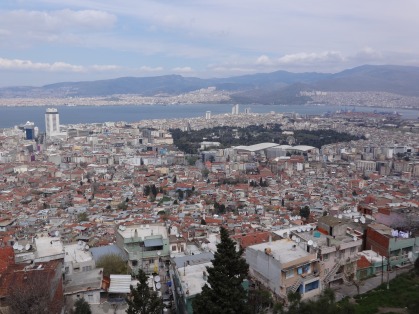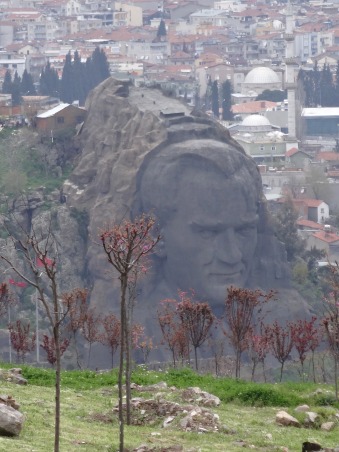“Velvet Castle”
Old name: Mt Pagus
Forming a dramatic backdrop to both Basmane and Konak in central İzmir is Kadifekale (Velvet Castle, 186m), a hilltop castle dating back to Byzantine times. The remains of the castle itself are not especially exciting but the views over the Gulf of İzmir (İzmir Körfezi) alone justify the trip up to it.
Not a lot seems to be known about the castle’s history but a story recounted by Pausanias in the 2nd century AD recounted how Alexander the Great had fallen asleep under a plane tree in front of a temple to Nemesis. In a dream the goddess advised him to build a new city on the slopes of Mt Pagus, a suggestion endorsed by the oracle of Apollo at Claros. Presumably the original fortifications would have been part of the new city although they will have been rebuilt many times over the centuries. Originally there were 24 towers ringing the walls, all of them named after figures from Ancient Greek mythology such as Artemis and Leto. Today half a dozen still stand and one of them offers panoramic views out over the city and the Gulf.  View from the Castle. The large patch of green in the middle is the site of the Fuar built over the Greek quarter annihilated by fire in 1922
View from the Castle. The large patch of green in the middle is the site of the Fuar built over the Greek quarter annihilated by fire in 1922
In the 2010s the hillside around the castle was cleared with a view to improving the landscaping. During the course of this work the remains of the old Roman theatre came to light. It is thought that it would have been able to accommodate an audience of 16,000 people and it seems likely that it was here that Izmir’s patron saint, Polycarp, was put to death in c. 160 (he was burnt at the stake, then stabbed to death).
Inside the ruined walls of the city are the remains of cisterns which were probably linked to the Agora and from which water would have been conveyed to the town centre.
Today women from Mardin and Midyat can usually be found here weaving colourful strips of carpet on simply made horizontal looms.
Looking out from the inland side of the castle you will see a 42m-high concrete bust of Atatürk (Atatürk Maskı) seemingly carved into the rock beside the road to Selçuk although it was actually built against the rockface using scaffolding. The work was designed by Harun Atalayman and completed in 2009. It is the tallest relief sculpture in the country.
 Transport info
Transport info
Buses run from Konak to the entrance of Kadifekale and it’s an easy stroll back down again. Until recently this was a poor area where visitors sometimes attracted the wrong sort of attention. Hopefully this situation will improve as more visitors are drawn in.
Dolmuşes also run from in front of the Agora ruins on Anafartalar Caddesi to the castle. The stop says Kadifekale but the dolmuşes read “Mezarlıkbaşı” (Cemetery)!


